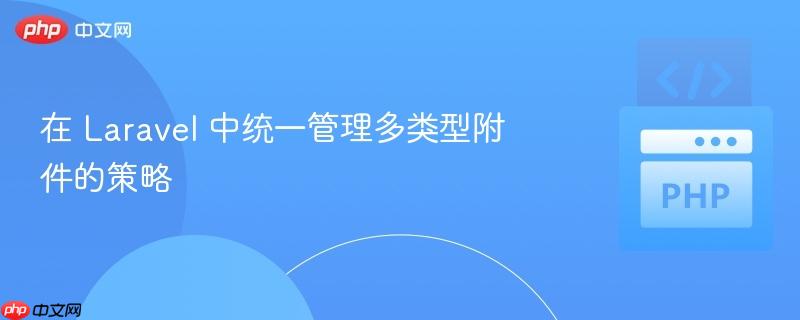
本文将详细介绍如何在 Laravel 应用中,通过构建一个统一的附件模型(Attachment Model)来管理不同类型(如图片、视频)的附件,并将其关联到父模型(如 Page)。这种方法简化了数据结构和访问逻辑,允许开发者以单一关系 (`hasMany`) 轻松地存储、检索和操作多种类型的附件,同时支持批量保存和迭代访问,避免了传统多态关联的复杂性。
在开发 Web 应用时,经常会遇到一个父级资源(例如文章、页面)需要关联多种不同类型子资源(例如图片、视频、文档)的需求。开发者通常希望能够通过一个统一的接口来访问这些子资源,例如 $page->attachments,并且能够方便地进行批量操作,如 $page->attachments()->saveMany($attachments)。虽然 Laravel 提供了强大的多态关联(Polymorphic Relationships)来处理这类问题,但在某些场景下,如果不同类型的附件在核心数据结构上高度相似,或者为了追求更简洁的数据库设计和模型关系,采用一个统一的附件模型可能是一个更直接有效的解决方案。
解决上述挑战的关键在于创建一个通用的 Attachment 模型和对应的数据库表。这个 Attachment 表将包含所有附件共有的字段,并引入一个 type 字段来区分附件的具体类型(例如 'image' 或 'video')。
首先,我们需要设计 attachments 表。该表应包含以下核心字段:
以下是 attachments 表的迁移文件示例:
// database/migrations/xxxx_xx_xx_create_attachments_table.php
use Illuminate\Database\Migrations\Migration;
use Illuminate\Database\Schema\Blueprint;
use Illuminate\Support\Facades\Schema;
class CreateAttachmentsTable extends Migration
{
public function up()
{
Schema::create('attachments', function (Blueprint $table) {
$table->id();
$table->foreignId('page_id')->constrained()->onDelete('cascade');
$table->string('file'); // 文件路径或名称
$table->string('type'); // 'image', 'video' 等
$table->timestamps();
});
}
public function down()
{
Schema::dropIfExists('attachments');
}
}接下来,定义 Attachment 模型和 Page 模型中的关联。
1. Attachment 模型
Attachment 模型将直接对应 attachments 表。
// app/Models/Attachment.php
namespace App\Models;
use Illuminate\Database\Eloquent\Factories\HasFactory;
use Illuminate\Database\Eloquent\Model;
class Attachment extends Model
{
use HasFactory;
protected $fillable = [
'file',
'type',
'page_id',
];
// 如果需要,可以定义一个反向关联到 Page
public function page()
{
return $this->belongsTo(Page::class);
}
}2. Page 模型
在 Page 模型中,定义一个 hasMany 关系,将其与 Attachment 模型关联起来。

采用三层架构开发,前台集成了产品在线展示,用户注册、在线调查、在线投稿后台有类别管理\图书管理\订单管理\会员管理\配送范围管理\邮件列表\广告管理\友情链接管理等后台添加图书时自动生成缩略图和文字水印主要参考了petshop的设计架构、使用了Asp.net2.0中很多MemberShip、master等新功能后台管理地址/web/admin/ 超级管理员账号密码均为aspx1特别提示:该系统需要
 0
0

// app/Models/Page.php
namespace App\Models;
use Illuminate\Database\Eloquent\Factories\HasFactory;
use Illuminate\Database\Eloquent\Model;
class Page extends Model
{
use HasFactory;
protected $fillable = [
'slug',
// ... 其他页面字段
];
public function attachments()
{
return $this->hasMany(Attachment::class);
}
}完成数据库和模型的设置后,我们可以开始进行数据的增删改查操作。
通过 Page 模型的 attachments 关系,可以方便地添加新的附件。
创建单个附件:
use App\Models\Page;
use App\Models\Attachment;
$page = Page::find(1); // 假设获取到 ID 为 1 的页面
// 创建一个图片附件
$imageAttachment = $page->attachments()->create([
'file' => 'images/example-image.jpg',
'type' => 'image',
]);
// 创建一个视频附件
$videoAttachment = $page->attachments()->create([
'file' => 'videos/example-video.mp4',
'type' => 'video',
]);批量保存附件:
为了实现批量保存,我们可以先创建 Attachment 模型的实例,然后使用 saveMany 方法。
use App\Models\Page; use App\Models\Attachment; $page = Page::find(1); $image = new Attachment(['file' => 'images/another-image.png', 'type' => 'image']); $video = new Attachment(['file' => 'videos/promo-video.mp4', 'type' => 'video']); $page->attachments()->saveMany([$image, $video]);
获取页面所有附件非常直接,就像获取任何 hasMany 关系一样。
use App\Models\Page;
$page = Page::find(1);
foreach ($page->attachments as $attachment) {
echo "附件 ID: " . $attachment->id . "\n";
echo "文件路径: " . $attachment->file . "\n";
echo "类型: " . $attachment->type . "\n";
if ($attachment->type === 'image') {
echo "这是一个图片附件。\n";
} elseif ($attachment->type === 'video') {
echo "这是一个视频附件。\n";
}
echo "-------------------\n";
}如果需要获取特定类型的附件,可以在查询时添加 where 条件。
use App\Models\Page;
$page = Page::find(1);
// 获取所有图片附件
$images = $page->attachments()->where('type', 'image')->get();
foreach ($images as $image) {
echo "图片文件: " . $image->file . "\n";
}
// 获取所有视频附件
$videos = $page->attachments()->where('type', 'video')->get();
foreach ($videos as $video) {
echo "视频文件: " . $video->file . "\n";
}通过构建一个统一的 Attachment 模型和表,并利用 type 字段进行区分,我们可以在 Laravel 中实现一个简洁高效的多类型附件管理方案。这种方法尤其适用于附件类型虽然不同,但其核心数据结构高度相似的场景。它不仅简化了数据库设计和模型关系,还提供了统一的接口进行附件的存储、检索和批量操作,大大提高了开发效率和代码的可读性。在选择具体实现方案时,开发者应根据项目的具体需求和附件数据结构的复杂性,权衡各种方法的优缺点。
以上就是在 Laravel 中统一管理多类型附件的策略的详细内容,更多请关注php中文网其它相关文章!

每个人都需要一台速度更快、更稳定的 PC。随着时间的推移,垃圾文件、旧注册表数据和不必要的后台进程会占用资源并降低性能。幸运的是,许多工具可以让 Windows 保持平稳运行。

Copyright 2014-2025 https://www.php.cn/ All Rights Reserved | php.cn | 湘ICP备2023035733号